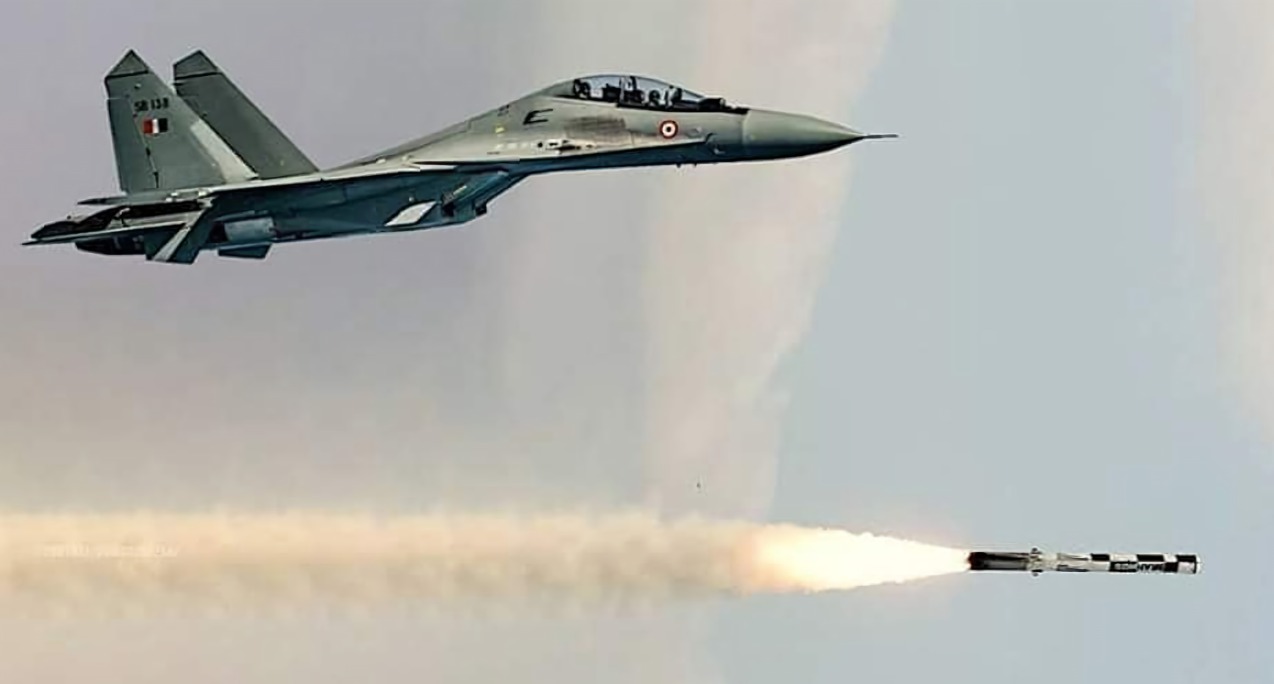The Indian Air Force (IAF) is integrating the Israeli Rampage long-range supersonic cruise missile with Russian fighter jets. This is one of the few instances of the pairing of Israeli technology with Russian weapons platforms to bolster the capability of the IAF.
The IAF announced the induction of the Rampage long-range supersonic air-to-ground missiles at the end of March 2024. The missile will give a major boost to the firepower of the existing fighter fleet of the force.
The missile, also known as the High-Speed Low Drag-Mark 2 missile in the IAF, was reportedly used by the Israeli Air Force in its recent attacks on Iranian targets.
The IAF first integrated the Rampage with its fleet of Russian-origin aircraft, including the Su-30 MKI and MiG-29s. The Indian Navy has also included the missile in its fleet for the MiG-29K naval fighter jets.
The stand-off weapon is apt for engaging and taking out targets like communication centers or radar stations. The missile’s range is more than the Spice-2000s used during the Balakot air strikes in Pakistan in 2019.
The missiles were procured under the emergency powers given to the armed forces in the aftermath of violent skirmishes with China in 2020.
The integration of Rampage with the Su-30 MKIs gives more teeth to the Russian fighter jet, which is now equipped with multiple long-range air-to-ground weapons. It can also fire the over 400 km range BrahMos supersonic cruise missiles. The IAF is considering producing Rampage in bulk under the ‘Make in India’ program.

Israel is one of the top arms suppliers to the Indian military. Over the years, Indian forces have inducted Barak surface-to-air missile systems, Spyder quick-reaction anti-aircraft missiles, and a wide array of drones and radars to Python and Derby air-to-air missiles, Crystal Maze and Spice-2000 precision-guided munitions.
This is not the first instance of Israeli technology bolstering a Russian platform for the IAF. The IAF operates three Israeli Phalcon Airborne Warning and Control Systems (AWACS) mounted on Russian Il-76 transport aircraft.
These Phalcon AWACS provide 360-degree radar coverage for a distance of 400 kilometers. India is the second country after Israel to have Il-76 Phalcon AWACS.
‘AWACS’ – Force Multiplier For The IAF
The AWACS made their first appearance during the 1973 Yom Kippur war. The Israeli military was on the back foot when the introduction of the new platform turned the tide of the war against the Egyptian forces.
Post-war analysis underscored that the AWACS won the war for Israel. Even today, flying radars are an important ‘force multiplier’ for conducting a full-spectrum, fast-paced air campaign.
The IAF is responsible for the country’s air defense, and AWACS has a vital role in the multi-layered air defense. These specialist aircraft are equipped with radars, sensors, and computers, which are critical in modern warfare because they can detect and track incoming fighters, cruise missiles, and drones much before ground-based radars.
They can guide friendly fighters during air combat and keep an eye on enemy troop build-ups and the movement of warships.
India was set on the path of developing airborne surveillance capability in 1985. Two new Avro HS 748 aircraft from the IAF were fitted with a rotodome, antenna, communications systems, etc. The platform was ready in 1991. The project, however, suffered a massive setback when one of the two rotodomed Avro aircraft crashed.

The criticality of the system for the IAF made India sign a tripartite agreement with Israel and Russia in 2004 to mount three Phalcon radars on Russian Il-76 aircraft. The deal was for US $1.5 billion. The IAF received its first AWACS on May 25, 2009.
Israeli SDRs To Help Russian-Supplied Jets In IAF
Five years ago, Indian fighter jets crossed the border with Pakistan for the first time since the 1971 war to bomb the Jaish-e-Mohammed’s terror training camp. When the Pakistan Air Force, with better electronic warfare jammers, retaliated, the IAF was found wanting an operational data link that restricted Indian Sukhois from communicating with its MiG-21s or MiG-29s.
In an era of electronic warfare, it was the blind spot of the IAF. The IAF’s MiG-21 aviator Wing Commander Abhinandan, who was captured in Pakistan in the aftermath, could not hear the instructions given by the ground controller as he did to have the software-defined radio, which obviated the noise clutter.
The lack of software-defined radio (SDR) impacted the IAF’s interoperability, as the electromagnetic spectrum played an important role in any war.
A source confirmed this to the EurAsian Times: “The IAF’s air-to-ground and ground-to-air network progressed well ahead of the peers. But the air-to-air network lagged. Neither we imported nor developed it indigenously.” The source refused to explicitly say how this would have impacted India’s response to Pakistan’s retaliatory strikes.
But in layman’s terms, it means that the flying radars could efficiently relay the situation to the ground stations, which in turn would pass on the information to fighter jets. However, communication between different fighter jets was not there.
After Operation Swift Retort by the PAF, the IAF expedited the procurement of BNET Software Defined Radios (SDR) from Israel and integrated them with its aircraft fleets. The emergency purchase of SDRs was made from Israeli firm Rafael for its Mirage-2000, MiG-29, and Sukhoi-30 fighter jets of the IAF.
The SDRs will ensure secure communication not just between fighters in the air but also between fighters in the air and on the ground, and, most importantly, between the fighters in the air and the AWACS. In the face of electronic jamming, communication can shift to another frequency, and the mission can go unhindered.
- Ritu Sharma has been a journalist for over a decade, writing on defense, foreign affairs, and nuclear technology.
- The author can be reached at ritu.sharma (at) mail.com
- Follow EurAsian Times on Google News





















